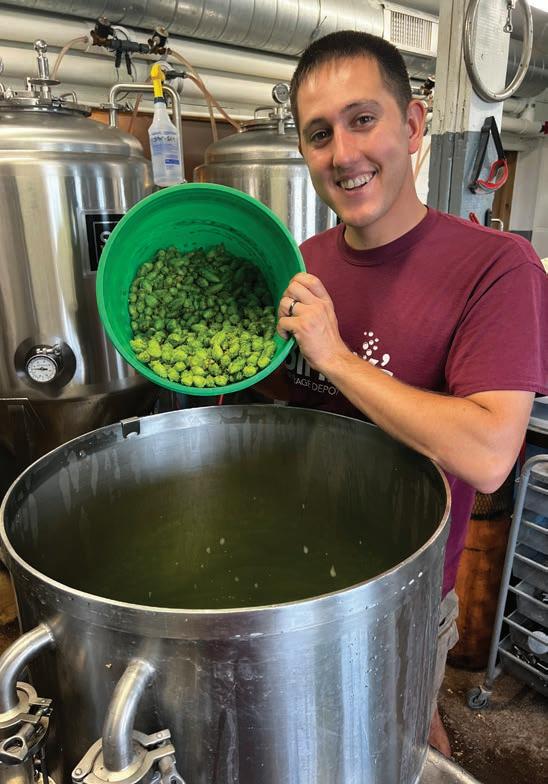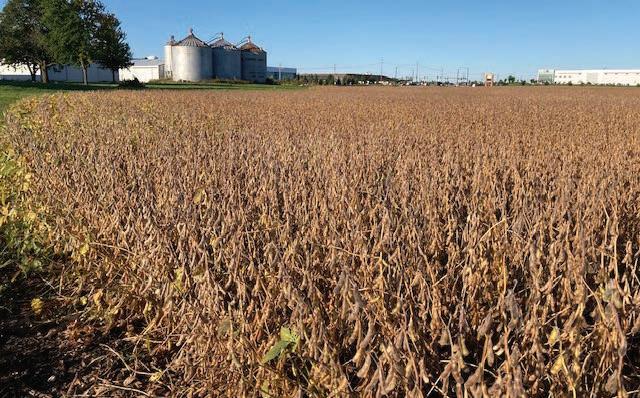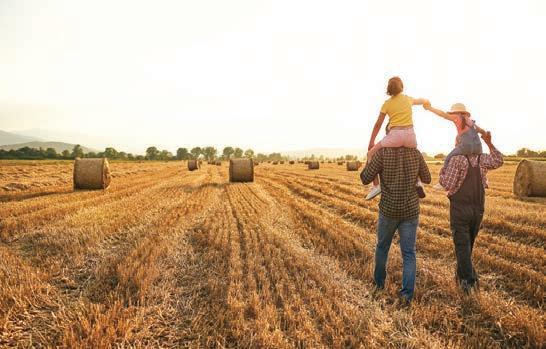
7 minute read
Harvested hops go directly into brewing process�������������������������������
By Tom C. Doran
AGRINEWS PUBLICATIONS
FAIRBURY, Ill. — The hops grown on the Emancipation Brewing Co. grounds were harvested a few weeks ago and headed toward cans or kegs.
“We harvested enough to brew a couple of things that we always like to brew, but there were no extra hops this year,” said Lincoln Slagel, Emancipation Brewing Co. co-owner and head br-ewer.
“We harvested and brewed on the same day and that beer will hopefully be coming out next weekend. It’s always one of my favorites.
“It’s always been said with grapes and things like that, that go into products like this, that if the plants are stressed, it can sometime create better flavor. These had a really good smell to them, so I’m excited to see how the beer turns out. The day we picked them, when they were just perfect and ready to go, just walking through with the light breeze, you could smell the hops.”
AGRONOMIC PLAN
Slagel is now preparing the perennial plants for the next growing season.
Rather than cutting off the top and bottom of the plants at harvest, Slagel will wait and cut the hop plants off before the first frost.
“They had a pretty hard winter and spring last year, so our hope is that we can give the leaves as much sunlight as we can this fall that maybe the plants will get a little stronger,” he said.
Emancipation Brewing is now making preparation for its Oktoberfest events.
“We always do our take on German beers using locally grown malt and hops. This year, we have seven German beers. All of them have some locally sourced grain and some, if not all, locally sourced hops,” Slagle noted.
BARLEY PRODUCTION
As is the case with the end-users of corn and soybeans, the brewing industry’s success and profitability hinges on supply, demand and subsequent prices of raw goods.
When AgriNews met with Slagel on Aug. 15, he had just received some of the latest data on U.S. barley production and input cost trends for the brewing industry.
The American Malting Association reported this year’s U.S. barley yield averaged 66.3 bushels per acre, up from last year’s 60.4, but it’s still down from 2020 and that was down from previous years.
Production went from about 165 million bushels in 2020 to 117.67 million bushels in 2021 and to nearly 158 million bushels this year.
“There was a big bo-unceback from last year, but the previous year is what we use up until at least a year after. A lot of these malting companies hold on to massive stockpiles and bring them out as they need them. Also, across the world there’s been a barley surplus and there’s always inventory up until basically last year with that smaller crop, plus the Russia-Ukraine situation, plus a drought in Canada’s south-central region where most of its barley is grown,” Slagel said.
“Our barley growing regions had drought conditions last year which is why our production was so bad.
“Ukraine is maybe the fourth largest barley producers in the world and from what I understand most of the Ukrainian farmers didn’t even plant a crop this year because they just couldn’t get to the field.”
INPUT COST TRENDS
Slagel also noted new data from Bart Watson, Brewers Association chief economist, on rising brewing input costs for paperboard, aluminum cans, general freight and trucking, malt and carbon dioxide.
“Everything started going way up beginning on Sept. 1, 2021, but the key one — malt — has basically doubled in price since a year ago as has carbon dioxide. There have been CO2 shortages. In some cases, CO2 has doubled, tripled, quadrupled in price,” he said.
“Our keg washer was broken and before we got it fixed this week, we had been taking our kegs to a brewery in the suburbs to wash them. This last week they told us that they can’t get enough CO2.
“When you’re done washing the kegs, they are purged with CO2 to get oxygen out. They said they didn’t have enough CO2 to let us wash our kegs there and only have enough to focus on their own kegs, even though we were paying them a fee.
“All those numbers really point to beer prices sadly going up. Aluminum cans have almost doubled in price since last year, too.”
Slagel said there is a little light at the end of the tunnel with slight decreases in trucking costs.
“There are also other costs that have gone up. We make a raspberry beer and when we first opened a 44-pound box of raspberries was $89. It was $250 the last time I purchased it, but other things aren’t affected. We make a pineapple beer and pineapple is less than half the price of raspberries,” he said.
“The nice thing though is the malting company we use in Indiana hasn’t raised their prices at all and part of it is the weather there has been good, the yields have been good and the numbers on their grains have been good when they send them to the lab.”
Minutes after these hops were harvested at Emancipation Brewery near Fairbury, Illinois, Lincoln Slagel put them in this large stainless-steel container to begin the brewing process�
Tom C. Doran can be reached at 815-410-2256 or tdoran@shawmedia.com. Follow him on Twitter at: @ AgNews_Doran.
Here on this property, it’s been pretty wet. It seems like every time we got rain in the area, we got more than average here.
A couple of the last few rains have been pretty timely to hopefully help. It will be interesting to see. It’s been a strange year in some ways with the cold spring. The rain situation wasn’t too bad this summer. There were a few dry weeks, but it seemed like every time we’d dig down there was still moisture there, at least here.
We always have the benefit and the drawback of being close to the river. So, if it rains too much it will flood from the river to about halfway here, but then we also benefit because the soil seems to hold moisture a little bit better.
For the rest of the family farms, they said they’ll start harvesting in the next week or two. These fields by the brewery will probably be close to the last ones that they’ll be harvesting.
Lincoln Slagel
FAIRBURY, ILL� There were 5�6 days suitable for fieldwork during the week ending Sept� 25� Statewide, the average temperature was 68�3 degrees, 6�4 degrees above normal� Precipitation averaged 0�88 inches, 0�05 inches above normal� Corn dough reached 96%, compared to the five-year average of 99%� Corn dented reached 81%, compared to the five-year average of 94%� Corn mature reached 47%, compared to the five-year average of 66%� Corn harvested for grain reached 6%, compared to the five-year average of 16%� Corn condition was rated 5% very poor, 6% poor, 20% fair, 53% good, and 16% excellent� Soybeans setting pods reached 96%, compared to the five-year average of 98%� Soybeans dropping leaves reached 63%, compared to the five-year average of 57%� Soybeans harvested reached 2%, compared to the five-year average of 10%� Soybean condition was rated 5% very poor, 6% poor, 23% fair, 51% good, 15% excellent� Winter wheat planted reached 1%, compared to the five-year average of 3%�




Skid Loader, Backhoe, Wheel Loader, Dozer & Excavator Work

• Basements • Water Lines • Septic Systems • Sewer Lines • Footings • Driveways
• Roll-Off Containers • Building Demolition • Free Estimates Fully Licensed and Insured Black Dirt and White Rock Custom Ag Applications • Concrete Recycling

Thanks to all the farmers out there. We're proud to help protect your hard work. Trust in Tomorrow.® TRUST US TO APPRECIATE YOUR DEDICATION
“Trust in Tomorrow.” and “Grinnell Mutual” are registered trademarks of Grinnell Mutual Reinsurance Company. © Grinnell Mutual Reinsurance Company, 2022. Thanks to all the farmers out there. We're proud to help protect your hard work. Trust in Tomorrow.® 245 Backbone Road East | Princeton, IL 61356 Phone: 815-875-4404 | DimondBros.com




